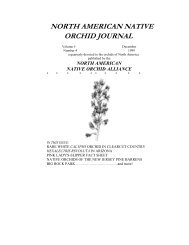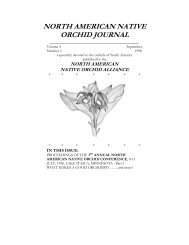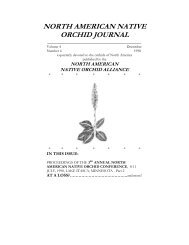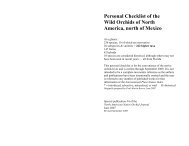north american native orchid journal - at The Culture Sheet
north american native orchid journal - at The Culture Sheet
north american native orchid journal - at The Culture Sheet
You also want an ePaper? Increase the reach of your titles
YUMPU automatically turns print PDFs into web optimized ePapers that Google loves.
Pelch<strong>at</strong>: SPIRANTHES PARKSII CORRELL – NAVASOTA LADIES’-TRESSES<br />
<strong>The</strong> plants I have observed are from 21 cm to 25 cm tall<br />
with the flowers taking up the top 7 cm - 8 cm of the spike (Fig.<br />
2). <strong>The</strong>y are in 4 ranked coils of 14 to 30 flowers th<strong>at</strong> spiral<br />
counterclockwise looking down on the top of the plant. <strong>The</strong><br />
plants tend to have the flowers concentr<strong>at</strong>ed more <strong>at</strong> the top of<br />
the rachis twisting, generally, in a CCW direction forming 4 ranks<br />
giving the rachis a symmetrical appearance. In contrast S. lacera<br />
var. gracilis tends to have a single rank forming a long spiral to the<br />
top for most of the length of the rachis. <strong>The</strong>re are no leaves<br />
present <strong>at</strong> anthesis, but I have observed the leaves of plants in the<br />
springtime and they form basal rosettes of 2 to 3 lance like elliptic<br />
shaped leaves (Fig. 7). It should be noted th<strong>at</strong> I find the number,<br />
size and dimensions of leaves for Spiranthes spp. to be quite<br />
variable depending on the time of year observed, the amount of<br />
moisture present and apparently the amount of nutrients in the<br />
soil. Plants of S. vernalis grown in pots and fed high nitrogen<br />
fertilizer have produced over 8 large grass like leaves along with<br />
one large bract like leaf on the spike th<strong>at</strong> have sustained through<br />
anthesis compared to the 4 to 5 often observed in the field.<br />
<strong>The</strong>se observ<strong>at</strong>ions suggest th<strong>at</strong> identific<strong>at</strong>ion of S. parksii based<br />
on veget<strong>at</strong>ive characteristics of the rosettes is highly unlikely<br />
unless the plants were specifically marked while in bloom.<br />
<strong>The</strong> flowers and most of the rachis are covered in a fine<br />
pubescence, the apex of which is tipped with a ball or club. <strong>The</strong><br />
same pubescence is found on S. cernua but S. lacera var. gracilis is<br />
essentially glabrous. <strong>The</strong> characteristically obov<strong>at</strong>e petals, (Correll<br />
1947), are also easily seen in the field through the lens of the<br />
camera or with a 10x loupe. <strong>The</strong> lip is presented in such away<br />
th<strong>at</strong> the apex has a cleft and the center leading inward to the<br />
column is padded on each side and creamy yellow in color, (this<br />
coloring is also described by C<strong>at</strong>ling & McIntosh 1979). <strong>The</strong><br />
margins of the lip are ragged and tooth like or in botanical terms<br />
dent<strong>at</strong>e compared to the crenul<strong>at</strong>e (scalloped or round toothed)<br />
and undul<strong>at</strong>e (wavy) appearance of S. cernua. Small pubescent<br />
29













